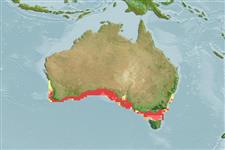Common names from other countries
分类 / Names
俗名 | 同种异名 | Catalog of Fishes(属, 种) | ITIS | CoL | WoRMS | Cloffa
Teleostei >
Eupercaria/misc (Various families in series Eupercaria) >
Sillaginidae (Smelt-whitings)
Etymology: Sillaginodes: See Sillago + Greek, oides = similar to.
More on author: Cuvier.
Environment: milieu / climate zone / depth range / distribution range
生态学
海洋; 半咸淡水 居于水底的; 非迁移的; 深度上下限 2 - 200 m (Ref. 6390), usually 2 - 18 m (Ref. 6205). 亞熱帶的; 29°S - 41°S, 112°E - 152°E (Ref. 6205)
Indo-West Pacific: southern Australia.
印度-西太平洋: 澳洲南部。
Length at first maturity / 大小 / 重量 / 年龄
Maturity: Lm 34.0, range 32 - 36 cm
Max length : 72.0 cm TL 雄鱼/尚未辨别雌雄; (Ref. 6205); common length : 35.0 cm TL 雄鱼/尚未辨别雌雄; (Ref. 9563); 最大体重: 4.8 kg (Ref. 6205); 最大年龄: 15 年 (Ref. 6390)
背棘 (总数) : 12 - 14; 背的软条 (总数) : 25 - 27; 臀棘: 2; 臀鳍软条: 21 - 24. The swim bladder is very elongate with a single slender tapering posterior extension and two anterolateral extensions. No duct-like urogenital aperture is present. Body color is pale brown, gray brown, or dark olive green above, and whitish pale brown or silvery below with reflections of mauve, blue green when fresh. The back and upper sides with oblique rows of small round dark brown to rusty brown spots; the lower sides with open-spaced rather scattered round dark spots. The belly is white and without spots. The dorsal fins are uniformly dark greenish brown to light brown sometimes spotted with dark brown; the anal, pectoral and pelvic fins are pale brown to hyaline; the caudal fin is greenish to brownish and finely dusted with brown (Ref. 6205).
泳鳔非常长的具有一个单一细长的尖端细的在后部的延长与二前外侧的延长。 没有像输送管一样的泌尿生殖器的孔存在。 体色是白褐色, 灰色褐色, 或深橄榄绿色的上方与微白色的白褐色或下面银色的具有淡紫色的反光, 蓝色的绿色新鲜时。 背部而且上侧面有列斜的小圆的深褐色的对赭褐色斑点; 下面的侧边具有开放的-有间隔的相当分散的深色圆斑。 腹面是白色的而且没有斑点。 背鳍是全黑色绿褐色的到淡褐色有时斑点深褐色的; 肛门者, 胸鳍与腹鳍是白褐色到透明的; 尾鳍是呈绿色到褐色的而且细地有褐色色晕了.(参考文献 6205)
Inhabit shallow inner continental shelf waters, including bays and inlets (Ref. 6390). For their first few years, they live mainly where seagrasses (Zostera species, Posidonia creeks. Small juveniles favor water depths from 2 m to 20 m. Adults inhabit more exposed waters along coastal beaches and reef areas (Ref. 27008, 27667), sometimes to depths as great as 200 m. Spawn in offshore waters from late summer to winter (Ref. 6390). Juveniles feed on benthic amphipods and other crustaceans. As they grow larger, their diet expands to include polychaete worms, mollusks and peanut worms (Sipuncula) (Ref. 27008, 27667). Oviparous (Ref. 205). This premium quality fish obtains a high price (Ref. 6205).
栖息于水浅的大陆棚内侧水域, 包括湾内。 (参考文献 6390) 他们的最初几年,他们主要地生活在哪里海草 ( Zostera 种, Posidonia 小溪。 小的稚鱼喜欢从 2 公尺到 20 公尺的水深度。 成鱼栖息于更多的裸露水域沿着海岸的海滩与礁区 (参考文献 27008,27667), 有时到深度深达 200 公尺。 产卵于从夏末到冬天的离岸水域中。 (参考文献 6390) 稚鱼吃底栖的片脚类动物与其他的甲壳动物。 当他们生长比较大, 他们的食性扩展到包括多毛類的蠕蟲,軟體動物與星蟲 ( Sipuncula).(參考文獻 27008,27667) 卵生的.(參考文獻 205) 這個高品質的魚獲得高的價格。 (參考文獻 6205)
Are serial batch spawners, yet the number of spawnings in a season is unknown (Ref. 6390).印度-西太平洋: 澳洲南部。
McKay, R.J., 1992. FAO Species Catalogue. Vol. 14. Sillaginid fishes of the world (family Sillaginidae). An annotated and illustrated catalogue of the sillago, smelt or Indo-Pacific whiting species known to date. Rome: FAO. FAO Fish. Synop. 125(14):87p. (Ref. 6205)
CITES (Ref. 128078)
Not Evaluated
人类利用
渔业: 商业性; 养殖: 实验的; 游钓鱼种: 是的
工具
特别资料
下载 XML
网络资源
Estimates based on models
Preferred temperature (Ref.
115969): 15.3 - 18.5, mean 17.4 (based on 253 cells).
Phylogenetic diversity index (Ref.
82804): PD
50 = 1.0000 [Uniqueness, from 0.5 = low to 2.0 = high].
Bayesian length-weight: a=0.00501 (0.00258 - 0.00973), b=3.07 (2.90 - 3.24), in cm Total Length, based on LWR estimates for this species & (Sub)family-body (Ref.
93245).
营养阶层 (Ref.
69278): 3.3 ±0.3 se; based on diet studies.
回复力 (Ref.
120179): 中等的, 族群倍增时间最少 1.4 - 4.4年 (K=0.47; tm=3-4; tmax=15; Fec=100,000).
Fishing Vulnerability (Ref.
59153): Moderate to high vulnerability (50 of 100).
